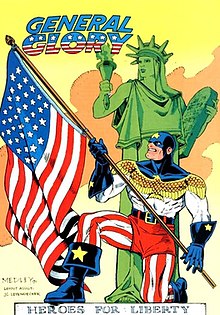
Red Tornado is a fictional character appearing in American comic books published by DC Comics. As the second character to assume the identity of Red Tornado, he is the result of an android being merged with a sentient tornado by T.O. Morrow.
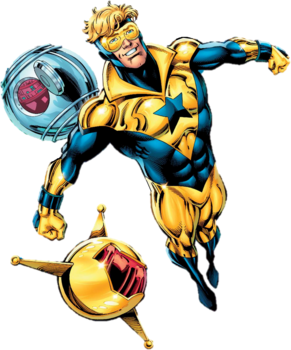
Booster Gold is a superhero appearing in American comic books published by DC Comics. Created by Dan Jurgens, the character first appeared in Booster Gold #1 and has been a member of the Justice League.

Big Barda is an antihero appearing in American comic books published by DC Comics. She first appeared in Mister Miracle #4, and was created by Jack Kirby. Jack Kirby based Barda's physical appearance on Lainie Kazan, who had recently appeared topless in Playboy. Mark Evanier, Kirby's assistant on the Fourth World comics, has explained the genesis of the character: "Jack based some of his characters on people in his life or in the news... the characterization between Scott 'Mister Miracle' Free and Barda was based largely—though with tongue in cheek—on the interplay between Kirby and his wife Roz". In 2011, Big Barda was ranked 75th in Comics Buyer's Guide's "100 Sexiest Women in Comics" list.
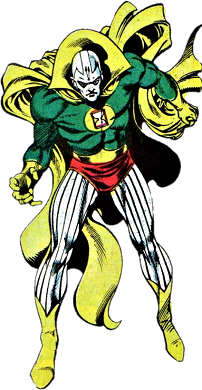
Chronos is the name of several supervillains appearing in American comic books published by DC Comics. These characters take their name from the Greek personification of time and have the ability to time travel. He is the archenemy of the Atom.
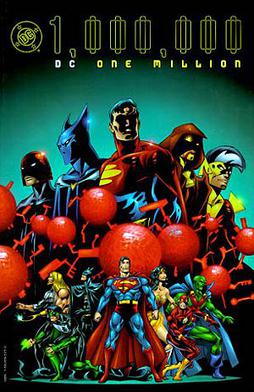
"DC One Million" is a comic book crossover storyline which ran through an eponymous weekly miniseries and through special issues of almost all of the "DCU" titles published by DC Comics in November 1998. It featured a vision of the DC Universe in the 853rd century, chosen because that is the century in which DC would have published issue #1,000,000 of Action Comics if it had maintained a regular monthly publishing schedule. The miniseries was written by Grant Morrison and drawn by Val Semeiks.
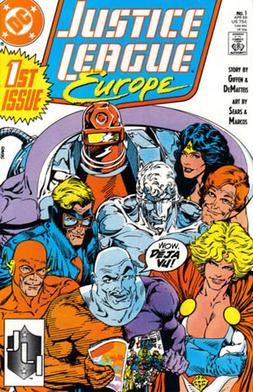
Justice League Europe (JLE) is a comic book series published by DC Comics that was a spin-off of the comic book Justice League America.

Justice League International (JLI) is a fictional DC comics superhero team that succeeded the original Justice League from the late 1980s to the early 2000s. The team enjoyed several comic books runs, the first being written by Keith Giffen and J. M. DeMatteis, with art by Kevin Maguire, created in 1987. Due to editorial conflicts, the team's new makeup was based largely on newer characters, such as Booster Gold, and recent acquisitions from other comic book companies, such as The Blue Beetle.
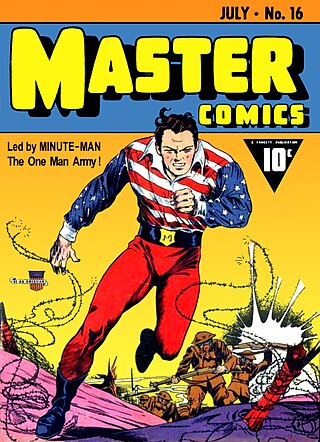
Minute-Man is a superhero appearing in comics published Fawcett Comics and later DC Comics.

Lucas "Snapper" Carr is a character appearing in American comic books published by DC Comics. The character was created by writer Gardner Fox and penciller Mike Sekowsky, and first appeared in The Brave and the Bold in February 1960. From 1960 to 1969, Snapper Carr appeared as a supporting character to the Justice League of America. The character occasionally appeared in comics featuring the Justice League from 1969 to 1989, when the Invasion! limited-series comic book gave him superpowers.

Gypsy is a superheroine appearing in American comic books published by DC Comics.
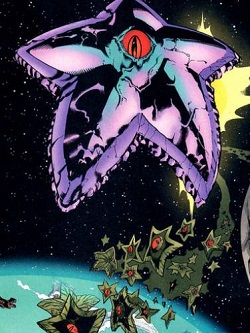
Starro is a supervillain appearing in American comic books published by DC Comics. The character first appeared in The Brave and the Bold #28, and was created by Gardner Fox and Mike Sekowsky.

Tasmanian Devil is a fictional superhero in the DC Comics universe. He first appeared in Super Friends #7. His first canon appearance is Infinity, Inc. #32.

Despero is a supervillain appearing in comic books published by DC Comics. The character first appeared in Justice League of America #1, and was created by Gardner Fox and Mike Sekowsky.

Extreme Justice is a monthly Justice League spin-off title in the DC Comics universe. It replaced the cancelled Justice League International and ran for nineteen issues from 1994 to 1996.
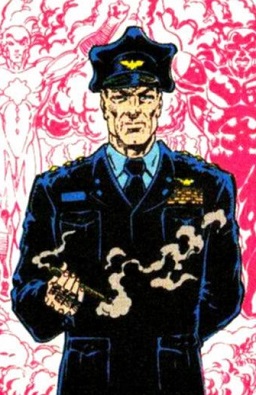
General Wade Eiling, sometimes known as The General, is a fictional character appearing in American comic books published by DC Comics.

The Cadre is a DC Comics supervillain group, except for members of the Cadre of the Immortal, most of whom were redeemed and became heroes by story's end.
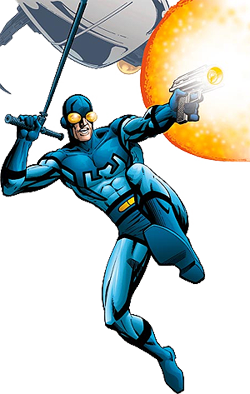
Theodore Stephen "Ted" Kord is the second Blue Beetle, a superhero who was originally published by Charlton Comics and later acquired by DC Comics. He was created by Steve Ditko and first appeared as a back-up feature in Captain Atom #83, with Gary Friedrich scripting from Ditko's conception and plot.

Congorilla, originally a human character known as Congo Bill, is a superhero appearing in comic books published by DC Comics and Vertigo Comics. Originally co-created by writer Whitney Ellsworth and artist George Papp, he was later transformed into Congorilla by Robert Bernstein and Howard Sherman. The character first appeared in More Fun Comics #56.
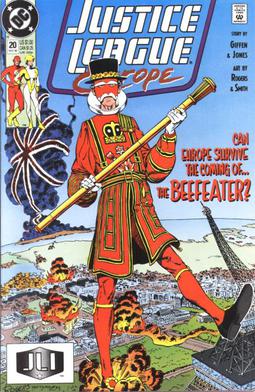
The Beefeater is a fictional character, a comic book superhero published by DC Comics. He appeared in his civilian identity as Michael Morice in Justice League International Annual #3 (1989), and debuted as Beefeater in Justice League Europe #20 in a story by Keith Giffen, Gerard Jones and Marshall Rogers. His code name and appearance are both taken from the uniform of the Yeomen Warders.

"The Lightning Saga" is a comic book crossover story arc that took place in DC Comics' two flagship team books: Justice League of America and Justice Society of America. It was written by Brad Meltzer and Geoff Johns, and illustrated by Ed Benes, Dale Eaglesham, and Shane Davis. It is notable for re-introducing the Legion of Super-Heroes in the post-Infinite Crisis era.
